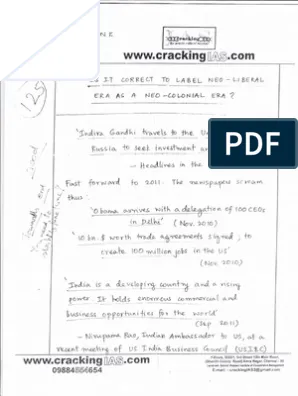- Home
- Prelims
- Mains
- Current Affairs
- Study Materials
- Test Series
NOVEMBER 27, 2025
National Judicial Appointment Commission (NJAC)
- Recently, Supreme Court agreed to consider a PIL questioning the Collegium system for appointment of judges in the top court and the High Courts and seeking revival of the National Judicial Appointment Commission (NJAC).
The NJAC Act, 2014
- Constitutional Amendment: Established by the 99th Constitutional Amendment to replace the Collegium system for higher Judiciary appointments.
- Composition: Appointments to be recommended by a six-member commission: the CJI, two senior Supreme Court judges, the Union Law Minister, and two eminent persons.
- Judicial Verdict: Struck down in the Fourth Judges Case (2015), for violating ''Basic Structure'' (Judicial Independence).
Concerns with the Collegium
- Opaqueness and Accountability Deficit: Collegium decisions are not answerable to any external authority—neither Parliament nor the executive.
- Exclusionary Nature: Collegium has been criticised for under-representation of women judges, inadequate presence from marginalized communities, etc.
- Constitutional ambiguity: Collegium system emerged from judicial interpretation (Three Judges Cases) undermining the principle that Parliament should determine institutional design.
- Vacancy: Persistent standoffs between the Collegium and Executive delay appointments.
Conclusion-
- While the Collegium system safeguards judicial independence, the concerns highlight the need for reform, such as a restructured National Judicial Appointments Commission (NJAC) with safeguards, or a collegium-plus model ensuring transparency, accountability, and diversity.
|
Existing System of appointments in Higher Judiciary
For appointments in High Courts:
|
Scheme to Promote Manufacturing of Sintered Rare Earth Permanent Magnets (REPM)
- The Union Cabinet has approved a ₹7,280-crore Scheme to Promote Manufacturing of Sintered Rare Earth Permanent Magnets (REPM) to reduce import dependence and build India’s first integrated REPM ecosystem.
- A first-of-its-kind national initiative to develop a complete domestic supply chain—from rare-earth oxides to metals, alloys and finished high-performance REPMs.
- Nodal Ministry: Ministry of Mines (with oversight from Department of Atomic Energy & NITI Aayog)
Targets:
- Establish 6,000 MTPA of integrated REPM manufacturing capacity
- Select 5 beneficiaries via global competitive bidding (each up to 1,200 MTPA)
- Build India’s first complete REPM value chain
Key features:
Financial Outlay: ₹7,280 crore
- A total of ₹7,280 crore is allocated to build India’s first large-scale, end-to-end Rare Earth Permanent Magnet (REPM) manufacturing ecosystem.
₹6,450 crore: Sales-linked incentives (for 5 years)
- ₹6,450 crore will be disbursed as incentives based on actual magnet sales, encouraging high-quality production and global competitiveness.
₹750 crore: Capital subsidy for plant setup
- ₹750 crore supports the heavy initial investment needed for oxide-to-metal conversion, alloying, and sintering technologies.
Duration: 7 years
- The entire scheme runs for 7 years, ensuring enough time for infrastructure creation, capacity building, and sustained production.
2-year gestation to build facilities
- Manufacturers get two years to construct integrated plants, install metallurgical systems, and stabilise rare-earth processing lines.
5-year incentive period
- For five years after commissioning, companies receive sales-based incentives to scale production and reduce import dependence.
Integrated Manufacturing Covered
- The scheme supports the full rare-earth value chain under one roof, promoting efficiency, cost reduction, and supply-chain security.
Rare-earth oxides → metals → alloys → sintered REPMs
- It enables India to convert raw rare-earth oxides into metals, process them into alloys, and finally produce high-performance NdFeB sintered magnets.
Sintered Rare Earth Permanent Magnets (REPM):
- REPMs (especially NdFeB magnets) are the strongest commercial magnets globally, made by sintering rare-earth-based alloys like Neodymium-Iron-Boron.
Rare Earth Permanent Magnets:
- They are a type of permanent magnet made from alloys of rare earth elements.
- Rare Earth Elements are a group of seventeen elements, including the fifteen lanthanides on the periodic table, along with scandium and yttrium.
- Properties: exceptional magnetic strength, high energy density, compact size with superior performance compared to other types of magnets.No viable substitutes in high-performance applications
- Applications: electric vehicles, renewable energy, electronics, aerospace, and defence sectors
Current Status in India:
- India has 6.9 million tonnes REE reserves (5th largest globally)
- Yet contributes ~1% to global production
- REPM demand is almost fully import-dependent
- China controls ~90% of global REPM supply
Commonwealth Games 2030 in India
- India has been formally ratified as the host of the 2030 Commonwealth Games, with Ahmedabad (Amdavad), Gujarat as venue.
- This will be the centenary edition of the Games, marking 100 years since the first British Empire Games were held in Hamilton, Canada, in 1930.
Commonwealth Games 2030:
- The Commonwealth Games are a quadrennial multi-sport event featuring athletes from member nations of the Commonwealth of Nations, blending Olympic-core sports with Games-specific disciplines like netball, lawn bowls and squash.
Brief History:
- Origin: Proposed in the late 19th–early 20th century as a “Pan-Britannic” sporting contest and first realised as the Inter-Empire Championships (1911).
- Formal start: The first British Empire Games were held in Hamilton, Canada, in 1930, with 11 countries and 400 athletes.
Name evolution:
- British Empire Games (up to 1950)
- British Empire and Commonwealth Games (1954–1966)
- British Commonwealth Games (1970–1974)
- Commonwealth Games (from 1978 onwards), reflecting decolonisation and equality among members.
2030 Host: Ahmedabad (Amdavad)
- The Commonwealth Sport General Assembly in Glasgow (Nov 2025) ratified Amdavad/Ahmedabad, Gujarat as host of the 2030 Centenary Commonwealth Games, after a vote of 74 member nations and territories.
- Ahmedabad’s bid builds around the Sardar Vallabhbhai Patel Sports Enclave and Narendra Modi Stadium sports infrastructure, aligning also with India’s long-term ambition to bid for the 2036 Olympics.
- India has been a regular participant since 1934, and first hosted the Games in Delhi 2010, which remain India’s best-ever multi-sport performance, finishing second on the medals tally.
About The Commonwealth:
- The Commonwealth of Nations is a voluntary association of independent and equal countries, many of which were formerly part of the British Empire, cooperating on the basis of shared values rather than formal political control.
Historical Evolution:
Early Commonwealth
- At the 1926 Imperial Conference, Britain and the Dominions agreed they were equal in status, forming what was then called the British Commonwealth of Nations—linked by allegiance to the British monarch but not ruled by the UK.
Birth of the Modern Commonwealth
- After World War II, many territories became fully independent.
- India’s independence in 1947 created a new situation: India wanted to be a republic, yet remain in the association.
- The London Declaration (1949) allowed republics and countries not owing allegiance to the British Crown to remain members, effectively creating the modern Commonwealth of Nations.
- Membership later expanded to countries with no direct colonial link to Britain
Sirpur Archaeological Site
- The Chhattisgarh government is preparing the 5th-century Sirpur archaeological site in Mahasamund district for a UNESCO World Heritage nomination, introducing digital exhibits, and battery-operated transport.
Sirpur Archaeological Site:
- Sirpur is a 5th–12th century multi-religious archaeological city known for its extraordinary concentration of Hindu temples, Buddhist viharas and Jain monuments, revealing the cultural and political vibrancy of Dakshina Kosala.
Location:
- Situated on the banks of the Mahanadi River, about 2 hours from Raipur, in Mahasamund district, Chhattisgarh.
History of the Site:
- First identified in 1882 by Alexander Cunningham; major excavations resumed in the 1950s, expanded in the 1990s and 2003 onwards.
- Served as the capital of Dakshina Kosala under the Panduvanshi and later Somavamshi kings (6th–8th century).
Excavations have revealed:
- 22 Shiva temples
- 5 Vishnu temples
- 10 Buddhist viharas
- 3 Jain viharas
- Archaeological evidence shows Sirpur was both a religious centre and a flourishing commercial-urban hub with palaces, markets, residential quarters, stupas and public infrastructure.
- Architecture of Sirpur: Sirpur displays a rare blend of Shaiva, Vaishnava, Buddhist and Jain architectural traditions, reflecting deep social harmony and artistic excellence.
Key Architectural Highlights:
Lakshmana Temple (7th century):
- One of India’s finest brick temples, built on a stone jagati.
- Sculpted brick shikhara, intricate door jamb carvings, Vishnu depictions and Maithuna panels.
Surang Tila Complex (7th century):
- Dramatic panchayatana temple set on a high 9-metre terrace accessed by 37 steps.
- Four Shiva shrines with differently coloured lingams and one Ganesha shrine.
- 32-pillared mandapa and signs of ancient seismic damage.
Teevardev Buddha Vihara (8th century):
- A large monastery with a monolithic Avalokiteshvara statue, inscriptions and ornate door jamb.
- Shows rare blending of Buddhist and Hindu iconography.
Baleshwar Temple (8th century):
- Carved pillars, lintels, elegant female figures and a marble Shiva lingam.
Gandheshwar Temple (18th century):
- A living temple enriched with reused sculptures from Sirpur’s ruins—Buddha images beside Shiva lingams—symbolising cultural continuity.
Urban Planning Features:
- Palace complexes, marketplaces, monasteries, stupas, meditation cells, water systems and a 6th-century market complex.









 Latest News
Latest News
 General Studies
General Studies